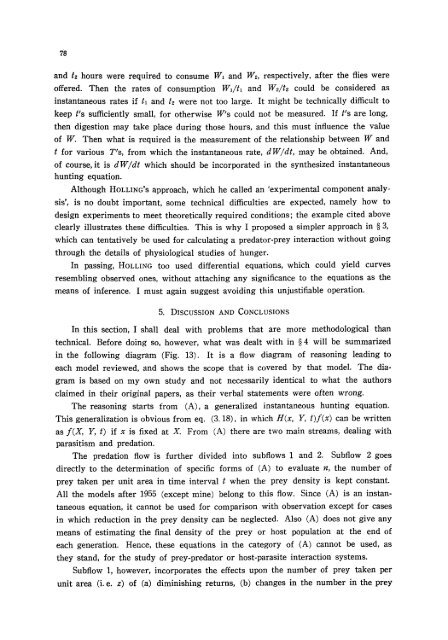A comparative study of models for predation and parasitism
A comparative study of models for predation and parasitism
A comparative study of models for predation and parasitism
You also want an ePaper? Increase the reach of your titles
YUMPU automatically turns print PDFs into web optimized ePapers that Google loves.
78<br />
<strong>and</strong> t2 hours were required to consume WI <strong>and</strong> Wz, respectively, after the flies were<br />
<strong>of</strong>fered. Then the rates <strong>of</strong> consumption W~/t~ <strong>and</strong> W2/t~ could be considered as<br />
instantaneous rates if tl <strong>and</strong> t2 were not too large. It might be technically difficult to<br />
keep tPs sufficiently small, <strong>for</strong> otherwise W's could not be measured. If t's are long,<br />
then digestion may take place during those hours, <strong>and</strong> this must influence the value<br />
<strong>of</strong> W. Then what is required is the measurement <strong>of</strong> the relationship between W <strong>and</strong><br />
t <strong>for</strong> various Tts, from which the instantaneous rate, d W/dt, may be obtained. And,<br />
<strong>of</strong> course, it is d W/dt which should be incorporated in the synthesized instantaneous<br />
hunting equation.<br />
Although HOLLING'S approach, which he called an 'experimental component analy-<br />
sis', is no doubt important, some technical difficulties are expected, namely how to<br />
design experiments to meet theoretically required conditions; the example cited above<br />
clearly illustrates these difficulties. This is why I proposed a simpler approach in w 3,<br />
which can tentatively be used <strong>for</strong> calculating a predator-prey interaction without going<br />
through the details <strong>of</strong> physiological studies <strong>of</strong> hunger.<br />
In passing, HULLING tOO used differential equations, which could yield curves<br />
resembling observed ones, without attaching any significance to the equations as the<br />
means <strong>of</strong> inference. I must again suggest avoiding this unjustifiable operation.<br />
5. DISCUSSION AND CONCLUSIONS<br />
In this section, I shall deal with problems that are more methodological than<br />
technical. Be<strong>for</strong>e doing so, however, what was dealt with in w 4 will be summarized<br />
in the following diagram (Fig. 13).<br />
It is a flow diagram <strong>of</strong> reasoning leading to<br />
each model reviewed, <strong>and</strong> shows the scope that is covered by that model. The dia-<br />
gram is based on my own <strong>study</strong> <strong>and</strong> not necessarily identical to what the authors<br />
claimed in their original papers, as their verbal statements were <strong>of</strong>ten wrong.<br />
The reasoning starts from (A), a generalized instantaneous hunting equation.<br />
This generalization is obvious from eq. (3. 18), in which H(x, Y, t)f(x) can be written<br />
as f(X, Y, t) if x is fixed at X. From (A) there are two main streams, dealing with<br />
<strong>parasitism</strong> <strong>and</strong> <strong>predation</strong>.<br />
The <strong>predation</strong> flow is further divided into subflows 1 <strong>and</strong> 2.<br />
Subflow 2 goes<br />
directly to the determination <strong>of</strong> specific <strong>for</strong>ms <strong>of</strong> (A) to evaluate n, the number <strong>of</strong><br />
prey taken per unit area in time interval t when the prey density is kept constant.<br />
All the <strong>models</strong> after 1955 (except mine) belong to this flow. Since (A) is an instan-<br />
taneous equation, it cannot be used <strong>for</strong> comparison with observation except <strong>for</strong> cases<br />
in which reduction in the prey density can be neglected. Also (A) does not give any<br />
means <strong>of</strong> estimating the final density <strong>of</strong> the prey or host population at the end <strong>of</strong><br />
each generation.<br />
Hence, these equations in the category <strong>of</strong> (A) cannot be used, as<br />
they st<strong>and</strong>, <strong>for</strong> the <strong>study</strong> <strong>of</strong> prey-predator or host-parasite interaction systems.<br />
Subflow 1, however, incorporates the effects upon the number <strong>of</strong> prey taken per<br />
unit area (i. e. z) <strong>of</strong> (a) diminishing returns, (b) changes in the number in the prey















